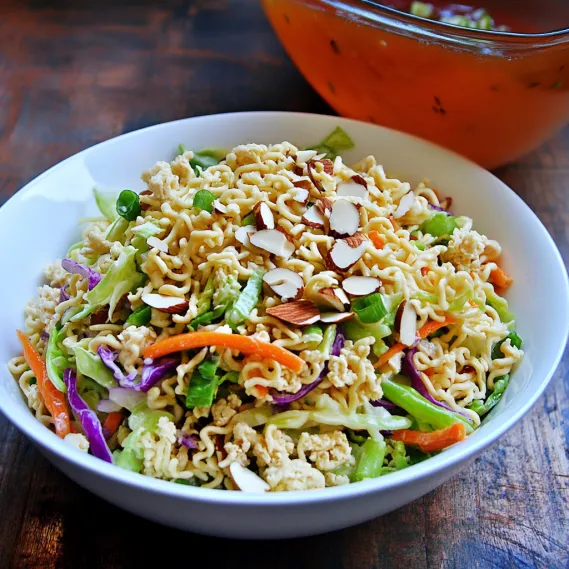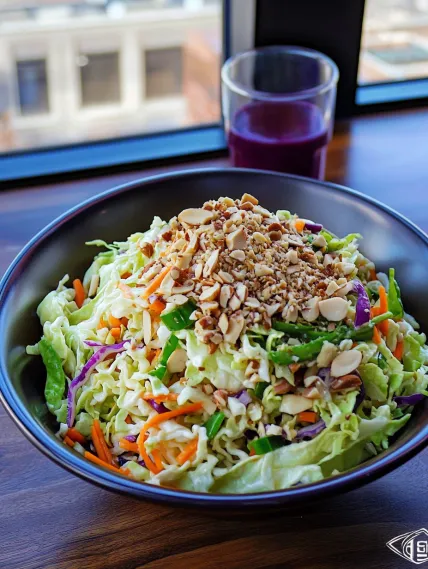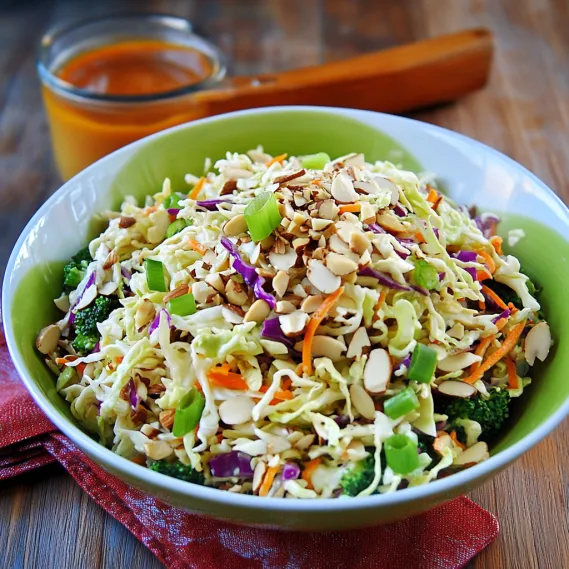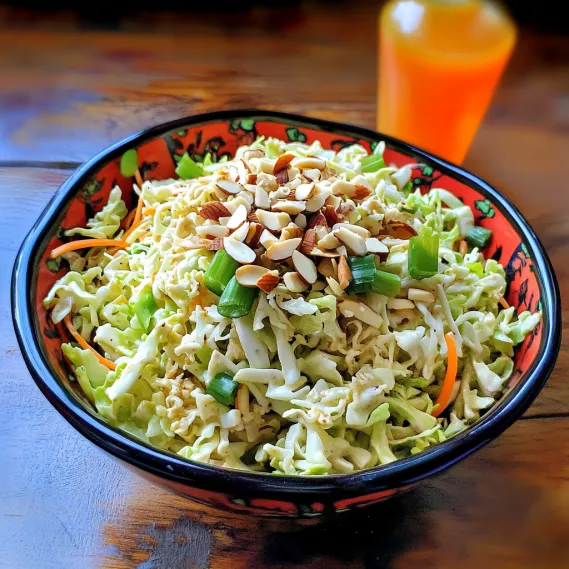 Pin it
Pin it
This Oriental Ramen Coleslaw combines crisp cabbage, crunchy ramen noodles, nuts, and seeds with a perfectly balanced sweet-savory dressing. The genius of this dish lies in using uncooked ramen as a creative, crunchy topping that transforms a simple coleslaw into something extraordinary. Each bite delivers a satisfying crunch and burst of flavor that keeps everyone coming back for more. Ready in just 10 minutes, this versatile salad shines at potlucks, picnics, or alongside any Asian-inspired meal.
I first discovered this recipe at a church potluck years ago and was initially skeptical about uncooked ramen on a salad. Growing up in the Philippines, I'd eaten plenty of ramen but never imagined enjoying it uncooked! After one bite, I was completely hooked by the unexpected crunch and flavor. This has since become my go-to side dish for Asian-themed dinners, especially when I'm short on time but want something guaranteed to impress.
Essential Ingredients and Selection Tips
- Coleslaw Mix: Use classic cabbage mix, broccoli slaw, or a combination of both for more color and texture variation. Pre-packaged mixes save valuable prep time.
- Ramen Noodles: Chicken-flavored works best, but use your favorite variety. The flavor packet becomes part of the dressing, so choose accordingly.
- Slivered Almonds: For maximum flavor, toast them lightly in a dry pan until golden brown. This simple step adds significant depth.
- Sunflower Seeds: Provides additional nutty flavor and crunch. Make sure they're fresh for best taste.
- Green Onions: Adds color and a mild onion flavor that complements the other ingredients perfectly.
I've discovered that toasting both the almonds and the ramen noodles before adding them to the salad creates an even more amazing depth of flavor. This extra step takes just a few minutes but elevates the entire dish to another level.
Detailed Cooking Instructions
- Step 1: Prepare The Fresh Components
- In a large salad bowl, combine one 16-ounce package of coleslaw mix with one bunch of thinly sliced green onions. Add 1/2 cup toasted slivered almonds and 1/2 cup sunflower seeds, distributing them evenly throughout the mixture. This creates the fresh, crunchy base of your salad.
- Step 2: Create The Perfect Dressing
- In a small bowl or jar, whisk together 1/2 cup sunflower or peanut oil, 1/3 cup rice vinegar (or apple cider vinegar), 2 teaspoons brown sugar, and the seasoning packet from the ramen noodles. Mix until completely combined and slightly thickened. This dressing perfectly balances tangy, savory, and slightly sweet notes.
- Step 3: Prepare The Ramen Topping
- Take one 3-ounce package of chicken-flavored ramen noodles (seasoning packet removed for the dressing) and break half the brick into small pieces. For extra flavor, you can lightly toast these broken noodles in a dry skillet until golden brown before adding to the salad. This enhances both flavor and crunch.
- Step 4: Combine With Perfect Timing
- About 15 minutes before serving, add half the broken ramen noodles to the coleslaw mixture. Pour the dressing over the top and toss thoroughly to coat all ingredients evenly. The brief standing time allows the vegetables to slightly soften and absorb the flavors while maintaining their crunch.
- Step 5: Finish With Texture Contrast
- Just before serving, break the remaining ramen noodles into pieces and sprinkle them on top of the dressed salad. Garnish with additional sliced green onions if desired. This two-stage addition of ramen creates layers of texture – some pieces softened slightly by the dressing and others maintaining maximum crunch.
 Pin it
Pin it
The first time I made this for my family, my husband was as skeptical as I had been initially. Now he requests this salad regularly, especially during summer barbecues. What surprised me most was how my children, typically reluctant to eat cabbage in any form, happily devoured this salad thanks to the crunchy, flavor-packed toppings.
Perfect Party Favorite
This coleslaw has become my signature contribution to neighborhood gatherings and family potlucks. What I love most is how it stands out among the typical mayo-based sides at summer barbecues. The vibrant colors and textures catch everyone's eye, and I've learned to bring printed recipe cards because I'm inevitably asked to share it. Last Fourth of July, I brought a double batch that disappeared within minutes, with even the most dedicated meat-lovers coming back for seconds of this vegetable dish. Something about the combination of crunch, savory flavor, and light dressing makes it irresistible even to those who typically bypass the salad table.
 Pin it
Pin it
Versatile Meal Companion
While this salad shines as a side dish, I've discovered numerous ways to transform it into a complete meal. For quick weeknight dinners, I often add sliced grilled chicken breast or leftover rotisserie chicken to make it more substantial. For a vegetarian protein boost, edamame beans work beautifully. During summer months, I've served it alongside teriyaki salmon or grilled shrimp for a light yet satisfying dinner that doesn't require turning on the oven. My teenage son even enjoys it wrapped in large lettuce leaves as a crunchy hand-held lunch option – proving how adaptable this simple salad can be.
Creative Variations
Over the years, I've experimented with several delicious variations that have become family favorites. For a tropical twist, try adding diced mango or mandarin orange segments, which provide sweet bursts that complement the savory dressing perfectly. When serving with spicier main dishes, I sometimes add a tablespoon of honey to the dressing for additional sweetness that balances heat. For extra color and nutrition, red bell peppers, shredded carrots, or even thinly sliced snow peas make wonderful additions. During autumn months, I sometimes substitute pepitas (pumpkin seeds) for the sunflower seeds and add dried cranberries for a seasonal variation that works beautifully with holiday meals.
Make-Ahead Strategy
For busy entertaining, I've developed a simple make-ahead strategy that ensures perfect results every time. Up to two days before serving, I prepare the vegetable mixture (cabbage, green onions) and store it in a sealed container. The dressing ingredients can be combined and refrigerated separately. I toast the almonds, sunflower seeds, and even the ramen noodles ahead of time, storing them in a zip-top bag at room temperature. Then, about 15 minutes before serving, I simply combine everything according to the recipe. This approach gives me all the convenience of advance preparation while maintaining the perfect texture that makes this salad so special.
 Pin it
Pin it
This Oriental Ramen Coleslaw has become more than just a recipe in our home – it's a reliable solution for potlucks, a requested side for family barbecues, and a way to get even the pickiest eaters to enjoy their vegetables. The combination of flavors and textures is simply magical, proving that sometimes the most surprising ingredient combinations create the most memorable dishes.
Frequently Asked Questions
- → Can I make this coleslaw ahead of time?
- You can prepare the components ahead of time, but it's best to assemble just before serving. You can mix the cabbage, green onions, almonds, and sunflower seeds up to a day in advance and store in the refrigerator. Make the dressing separately and store at room temperature. Add the ramen noodles and dressing just 15-20 minutes before serving to maintain the perfect crunch.
- → How can I make this recipe vegetarian?
- To make this vegetarian, simply use vegetable-flavored ramen noodles instead of chicken-flavored ones. You can also use a vegetable bouillon cube crushed into powder as a substitute for the ramen seasoning packet.
- → What can I substitute for the almonds if I have a nut allergy?
- If you have a nut allergy, you can simply omit the almonds and double the sunflower seeds. Or try substituting with pumpkin seeds (pepitas) or crispy wonton strips for a similar crunchy texture without nuts.
- → What protein works best if I want to make this a main dish?
- Grilled chicken breast or thighs work wonderfully with the Asian flavors in this coleslaw. Other great options include shredded rotisserie chicken, grilled shrimp, or thinly sliced beef. For a vegetarian protein option, try adding edamame beans or cubed firm tofu marinated in a bit of soy sauce.
- → Can I use a different type of oil in the dressing?
- Yes, while the recipe calls for sunflower or peanut oil, you can substitute with other mild-flavored oils like canola, vegetable, or light olive oil. For added Asian flavor, try using a small amount of sesame oil (1-2 teaspoons) combined with another neutral oil.
- → What's the best way to toast the ramen noodles?
- To toast ramen noodles, break them up while still in the package, then spread them on a baking sheet and bake at 350°F (175°C) for about 5-7 minutes until golden brown. Alternatively, toast them in a dry skillet over medium heat, stirring frequently until they turn golden brown. Watch carefully as they can burn quickly!
